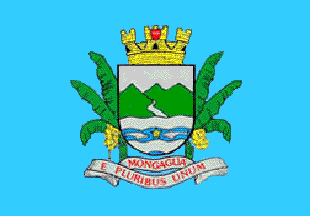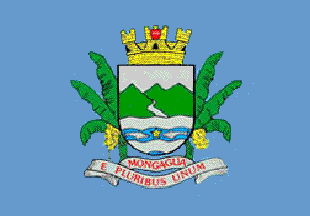 image by Dirk Schönberger,
10 December 2012
image by Dirk Schönberger,
10 December 2012Based on: http://www.mongagua.sp.gov.br/prefeitura.html

Last modified: 2012-12-29 by ian macdonald
Keywords: sao paulo | mongaguá |
Links: FOTW homepage |
search |
disclaimer and copyright |
write us |
mirrors
 image by Dirk Schönberger,
10 December 2012
image by Dirk Schönberger,
10 December 2012
Based on:
http://www.mongagua.sp.gov.br/prefeitura.html
A medium to light blue flag bearing the municipal arms in the centre.
Official website at
http://www.mongagua.sp.gov.br
Dirk Schönberger,
10 December 2012
Mongaguá was located between the two oldest colonial towns founded in Brazil, Vila de São Vicente - founded on 22 January 1532 by Martim Afonso de Sousa -, and Nossa Senhora da Conceição de Itanhaém - founded on 22 April 1532. Mongaguá was soon incorporated to the Captaincy of São Vicente, awarded to Martim Afonso de Sousa. His heiress, Marianna de Sousa Guerra, Countess of Vimieiros, was in trouble with the Count of Monsanto, the heir of Pero de Sousa, Martim Afonso's brother. The Countess founded the Captaincy of Itanhaém, the border between the two rival borders being river Mongaguá.
Mongaguá means in Tupi-Guarani "a cove with sticky mud". The natives
coined this name because the mouth of the river moved from time to
time, according to the prevailing winds. They also called it Ghost
River.
In 1913, the Mongaguá railway station was established in a place
called Praia Grande, the Big Beach. The engineer Fernando Arens Jr is
credited the foundation of the town, as the owner of the "Companhia de
Melhoramentos da Praia Grande". He also set up a cableway between the
banana plantations and the railway, the Hotel Clube Marinho and the
first roads in the region.
The district of Mongaguá, seceding from São Vicente, was incorporated
to Itanhaém in 1948. Following a plebiscite held on 7 December 1958,
the municipality of Mongaguá was established on 31 December 1958 by
State Law No. 5,121, corrected on 18 February 1959 by State Law no.
5,285.
http://www.livromongagua.com/historia/historia-de-mongagua - History
of Mongaguá, by Marcelo Vidice Dianno
The symbols of Mongaguá are prescribed by Decree no. 2 of 5 January 1960. They were designed by the Portuguese António Martins Araújo, winner of a public contest initiated by the Municipal Councillors João Dias de Oliveira and Dina Belli.
The flag is prescribed as "celeste blue, with the municipal coat of
arms in the middle". Marcelo Vidice Dianno claimed that the flags in
actual use on official buildings and during municipal ceremonies have
a darker shade of blue, and asked for a standardization of the shade
The flag should be hoisted over the Town Hall and in the room of the
Municipal Council, together with the flags of Brazil and São Paulo
State.
http://www.livromongagua.com/historia/a-bandeira - Flag of Mongaguá,
by Marcelo Vidice Dianno
Marcelo Vidice Dianno might have been heard since photos consistently show the flag as celeste blue.
http://www.soromusic.com.br/noticias-mongagua.asp?id_noticia=2
http://www.jornalcomunitario.com.br/portal/site/index.php?p=materias_ver&id=1259
http://simaopedro.com.br/simao-pedro-trata-de-acoes-na-area-rual-com-prefeito-de-mongagua
http://www.jornalcomunitario.com.br/portal/site/index.php?p=materias_ver&id=262
http://radiomongagua.blogspot.fr/2010/12/mongagua-composicao-da-mesa-diretora-da.html
http://www.santaceciliatv.com.br/1937-Noticias/Mongagua-e-Sanmen-China-serao-cidades-irmas
The coat of arms is made of a modern Portuguese shield surmounted by a mural crown charged with year "1959". The shield is surrounded by two banana trees fructed proper. On the shield, three mounts represents the Serra do Mar mountains, from which rises river Mongaguá. In base, a starfish surrounded by two fishes on a wave representing the sea. Below the shield a scroll inscribed with the place's name and the motto "E PLURIBUS UNUM".
The President of the Heraldry Brazilian Association spoke highly of
the coat of arms, for its "rich content and meaning".
http://www.livromongagua.com/historia/historia-de-mongagua - Flag of Mongaguá, by Marcelo Vidice Dianno
On some documents and flags, the motto below the coat of arms is
mistakenly written "ET PLURIBUS UNUM", instead of "E PLURIBUS UNUM".
http://www.livromongagua.com/historia/e-pluribus-unum - Coat of arms
of Mongaguá, by Marcelo Vidice Dianno
Ivan Sache, 13 December 2012
 image by Ivan Sache, 13 December
2012
image by Ivan Sache, 13 December
2012
Flag with darker blue shade, reportedly once in use.
Ivan Sache,
13 December 2012